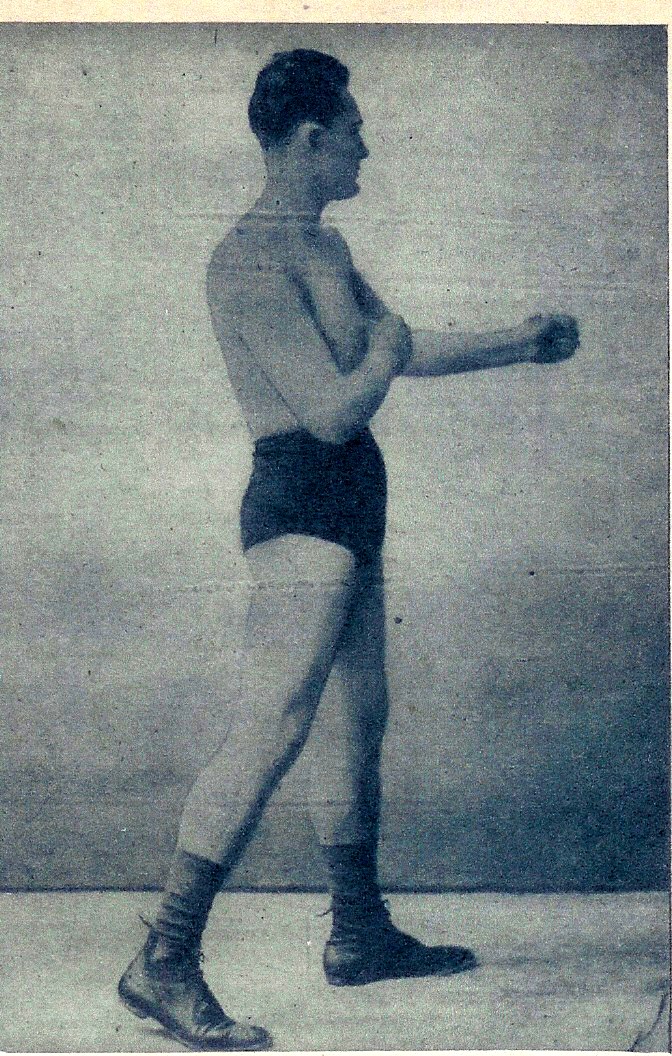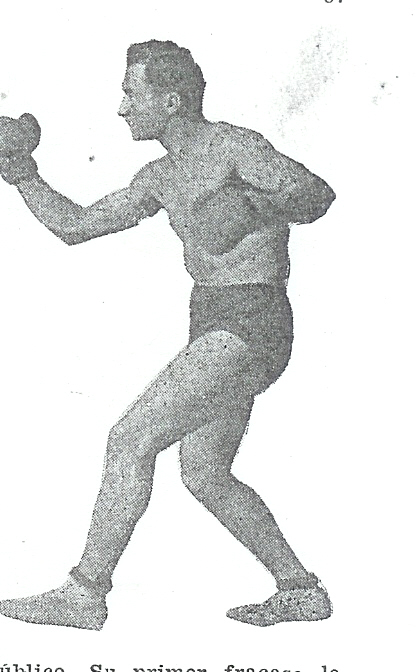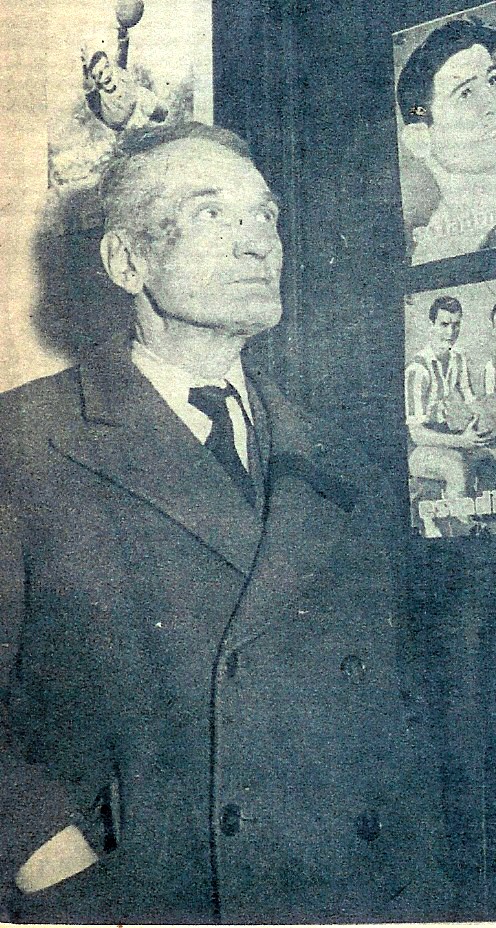JULY
2007
01 | The Life and Times of
a Boxing Pioneer
By Enrique
Encinosa
02 | Poem of the
Month
By Colleen Aycock
03 | In the Ring with James J. Corbett : Book Sample
By Adam Pollack
04 | My Candidate for
Manager of the Year: Cameron Dunkin
By Adam Pollack
05 | Touching
Gloves with Ruben Navarro
By
Dan Hanley
06 | Flashback
to the 2006 World Boxing Hall of Fame Banquet
By Dan Hanley
07 | Why the Old Soviet
Block of Nations is having Success in Boxing
By Rocky Alkazoff
08 | "I'm from Down-Under
too" Reflections from IBHOF 2007
By Orion Foote
09 | Prelims:the Art &
Science of Matchmaking [pdf]
By Don
Cogswell

10 |
Boxing's Lineal Mathematics : Champion Versus Champion
By
Cliff Rold
|

The Life and Times of a Boxing Pioneer
by ENRIQUE ENCINOSA
Few men in history have laid claim to being pioneers that launched boxing in a
nation. There was James Figg in England, proprietor of the first boxing academy
making prizefighting the rage of the Fancy in the British Isles. There was
old-timer Bobby Dobbs, instrumental in popularizing boxing in Germany in 1910.
And there was John Budinich.
Even boxing historians shrug at the mention of the name. John Budinich is a
forgotten name in ring annals, yet he was a trailblazer whose sketchy and very
adventurous life deserves to be told.
John Budinich Taborga was born in Coquimbo, Chile, sometime in 1881, growing up
in a middle class background, his father being a merchant marine captain. As a
boy from a seafaring family he was groomed to be a naval officer.
An athletic teen, Budinich was mesmerized by boxing and tales of the ring, yet
the sport did not exist in Chile. There was interest in pugilism but the country
lacked skilled coaches or experienced fighters. Without trainers or fighters,
promoters could not exist. .
It was logical that boxing would start in a seaport town like Valparaiso, where
some of the British or American merchant mariners passing through had knowledge
of boxing basics. By 1897 the Colonel Urriola Athletic Club in Valparaiso
started to host amateur smokers in which local brawlers fought with more zest
than skills.
Budinich was one of the pioneer boxers at the Urriola Club but unlike most of
the warriors participating in the smokers, John had professional training. As
luck would have it, the naval cadet had struck a friendship with a blacksmith
named McDonald, who had some ring experience in his native Ireland, before
moving to Chile.
McDonald coached the naval cadet. The strapping teenager learned footwork,
jabbing, balance, honing his basic skills in dozens of sparring sessions with
his teacher at the back yard of the veteran fighter's blacksmith shop.
In his three years as a naval cadet, young Budinich also became the star
attraction at the Urriola Club smokers, consistently winning, outclassing the
brawling longshoremen, mariners and local youths who tried their luck in the
ring.
By 1902 Budinich had dropped out of the naval academy and opened up his own
boxing academy in the city of Santiago, in partnership with a transplanted
lightweight named Daly. He also worked as an English translator and sports
writer for the newspaper "La Union."
Encouraged by the fact that amateur boxing was developing in several cities in
Chile, Budinich decided to introduce professional boxing in his homeland.
The first pro boxing card in Chile was held at the Santiago Theater, where
Budinich made his pro debut by knocking out a British light heavyweight named
Frank Jones. A few months later, sometime in 1903, Budinich won a twenty rounder
on points over an American fighter named James Perry.
Twenty-two year old Budinich had achieved a measure of national fame in Chile,
being its first amateur and pro star. Most young men would have enjoyed their
local fame and never left Chile, content to be headlining club shows, running a
gym and working as a sportswriter, but John Budinich liked to travel.
He left Chile sometime in 1903, working on merchant boats until he reached New
York. The Chilean had a good knowledge of English that improved with practice.
He enrolled at Columbia University where he studied physical education. He
claimed to have paid for his studies working as a waiter, occasionally boxing in
prelim bouts and even being a sparring partner for the magnificent Philadelphia
Jack O'Brien.
"The most pleasant moments of my boxing career," Budinich said in an interview
years later, "were spent with that man. He was phenomenal in his ability…"
 Indeed,
the cultured former naval cadet and university student did probably have the
personality to mesh well with the champion, for Philadelphia Jack was also from
a middle class background and was intellectually verbose and charming. Indeed,
the cultured former naval cadet and university student did probably have the
personality to mesh well with the champion, for Philadelphia Jack was also from
a middle class background and was intellectually verbose and charming.
After his university studies, the Chilean fighter continued his roaming ways. A
cargo boat took him to Europe and a merchant vessel brought him back; by 1908
Budinich landed in Colon , Panama, looking to fight a local hero named Sam Odon.
Panama was a busy country, where thirty three thousand workers toiled building a
historic canal across the isthmus. The many Americans and Europeans working on
the project had introduced boxing in Panama and Odon was one of the early local
heroes in the fight promotions, scoring several knockouts in crowd pleasing
fashion.
Budinich –at twenty seven years of age- was probably at his peak with over a
decade of ring experience under his belt; he was well conditioned and his sharp
mind understood the need of self promotion. As soon as he arrived in Panama, the
Chilean found and convinced several gamblers to back him betting on himself.
"In the very first round," Budinich said in an interview, years later, "I was
dropped to the canvas by a well timed blow."
Standing up, somewhat groggy, Budinich attempted to ward off the local light
heavyweight.
"I defended myself," he said, "and suddenly, I landed a right and to the floor
he went. From there on, I went full gallop."
The fight went the distance and the Chilean won on points, pocketing five
thousand dollars from his purse and the gamblers bets.
In 1910, John Budinich headed for Cuba, where he found a virgin territory for
his pugilistic ambitions.
Boxing in Cuba was non-existent. A couple of Cubans – Eugene Garcia and Emilio
Sanchez had boxed professionally in New York but had never fought in their own
country. Although boxing was not yet practiced, it was well covered by Havana
newspapers and tabloids of the time. The list of journalists that had covered
fights even included Jose Marti, the great Nineteenth Century writer and Cuban
nationalist, who was a ringside correspondent at the Sullivan-Ryan bare-knuckle
contest.
In a land without trainers or organized boxing, Budinich provided a desired
need. As in his native Chile, he became Cuba's boxing messiah. He set up shop in
Havana, renting a locale, setting up a ring and gym bags and printing flyers to
advertise the grand opening of Cuba 's first boxing academy.
Within weeks his boxing school was packed with eager young men willing to pay
gym fees and private lessons. The group of hopefuls included longshoremen,
construction workers, blacksmiths and a considerable group of well-bred
university students, the young sportsmen of Havana 's society set.
A cultured conversationalist, the Chilean also evidently possessed some social
skills, for within weeks of his arrival he was appointed boxing instructor at
the "Vedado Tennis Club," teaching the aristocracy how to jab. With a prosperous
gym and a salary at the country club, the enterprising prelim fighter was ready
for the next step in his career as a boxing impresario.
In order for boxing to progress, there had to be fights and paying audiences.
Budinich became a promoter, running amateur shows in the Actualidades Theater,
as well as in dance halls or even in private homes with large courtyards, where
he was also –very often- referee and sole judge.
In 1912, after promoting several amateur cards to small audiences, Budinich
announced his first pro boxing show at the Payret Theater in downtown Havana .
Since he was the only experienced pro in Cuba, Budinich announced that he would
not only promote, but would also fight in the main event star bout.
The Chilean was a good boxing teacher and a clever entrepreneur, but not a good
matchmaker. Instead of picking a soft opponent, Budinich brought Jack Ryan to
Havana . Ryan was a seasoned fighter who had traded leather with several top
fighters, including the magnificent Jack Dillon.
It took Ryan two rounds to knock out Budinich.
Budinich decided –for a while- to stick to training and promoting. He toured
several cities in Cuba with a crew of young fighters, fighting exhibitions. One
of his prospects was a heavyweight named Anastasio Penalver, proclaimed as the
new "Heavyweight Champion of Cuba," based on a few victories over other raw
novices.
Top American heavyweight John Lester Johnson was matched to fight Penalver in a
main event bout in Havana in 1915. The muscular but over matched Penalver was
stopped in the second round, towel thrown in by corner as Johnson pummeled the
Cuban.
Not content with one beating, Penalver faced Johnson in a rematch and was
stopped even faster. The Cuban heavyweight was not gracious in defeat, causing
an incident after the end of the fight card, when he threatened Johnson, using a
stone as weapon.
Budinich decided to return to the ring to avenge Penalver's fistic demise, but
first, he fought a draw against Jack Sentell, a durable and tricky club fighter
from Jacksonville , Florida.
John Lester Johnson was a fringe contender, one of a group of black fighters who
often fought each other in what was called the "Chitling Circuit." At the time
he fought Budinich, John Lester was a dangerous body puncher with solid skills,
destined to break Jack Dempsey's ribs in a future bout. Johnson stopped Budinich
in the very first round with a wicked body shot.
In five years Budinich had successfully introduced a sport in a nation. Although
none of his students attained international acclaim or contender status,
Budinich did train a crop of good local heroes, several becoming trainers and
gym owners after hanging up the gloves, including clever Victor Achan, tough
Mike Febles, lightweight slugger Tomas Galiana and feather weight Chau Aranguren.
By 1915, although other gyms had opened and an American named Brandt was new
competition in the promotional level, the Chilean was doing well. Budinich was
not wealthy but his income was enough to live in modest comfort. There was the
gym and the local pros he managed, plus his country club salary and a small
profit from promoting boxing shows at small venues. He married a Spanish woman
and many believed that he would stay in Cuba, involved in the development of the
sport, but the Chilean had a sense of adventure.
One day he left Cuba. Some claimed and newspapers printed the story that the
Chilean had decided to fight in the great epic in Europe, where men were
fighting in bloody trenches and tiny planes engaged in aerial combat over a war
torn land. It was announced that John Budinich had sold his gym and was off to
France, to wear the Kepi Blanc of the French Foreign Legion
Whether he did or not go to war, not much is known. John Budinich never returned
to Cuba and for a time it was believed that he had died in some forgotten
barricade, like Allan Seeger.
Luckily, the reports of his death were highly exaggerated. His ring career over,
Budinich returned to Chile with his wife, opening his third boxing academy, a
well run operation on the first block of Ahumada Street in Santiago. He became a
boxing instructor at Juan Enrique Concha University and was also in charge of
the boxing program for the Carabineri, the Chilean national police.
In 1945, the National Boxing Federation of Chile awarded him a well deserved
pension for his lifelong achievement in boxing.
After all, how many men can claim to have pioneered boxing in two different
countries.

contents
|

